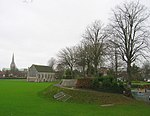Chichester Festival Theatre is a theatre and Grade II* listed building situated in Oaklands Park in the city of Chichester, West Sussex, England. Designed by Philip Powell and Hidalgo Moya, it was opened by its founder Leslie Evershed-Martin in 1962. The smaller and more intimate Minerva Theatre was built nearby in 1989.
The inaugural Artistic Director was Sir Laurence Olivier, and it was at Chichester that the first National Theatre company was formed. Chichester's productions would transfer to the National Theatre's base at the Old Vic in London. The opening productions in 1962 were: The Chances by John Fletcher (first production 1638) which opened on 3 July; The Broken Heart (1633), by John Ford, opened 9 July; Uncle Vanya (1896), by Anton Chekov, opened 16 July. Among the actors in the opening season were: Lewis Casson, Fay Compton, Joan Greenwood, Rosemary Harris, Kathleen Harrison, Keith Michell, André Morell, John Neville, Laurence Olivier, Joan Plowright, Michael Redgrave, Athene Seyler, Sybil Thorndike and Peter Woodthorpe.
The Festival Season usually runs from April to October and includes productions from classics to contemporary writing and musicals, reaching an audience of 230,000. Productions originated at Chichester frequently transfer to London or tour nationally and internationally.
A range of additional events is designed to add to the experience of visiting the theatre, including performances, cabarets, family days, tours and talks. Through the winter months, the Theatre presents touring productions and a Christmas show mounted by Chichester Festival Youth Theatre. The Theatre runs a large and active Learning, Education and Participation programme for all ages; its Youth Theatre is one of the largest in the country, with over 800 members.
The Theatre is a registered charity and is chaired by Mark Foster. Daniel Evans has been the artistic director since July 2016, sharing the leadership of the theatre with Executive Director Kathy Bourne.








